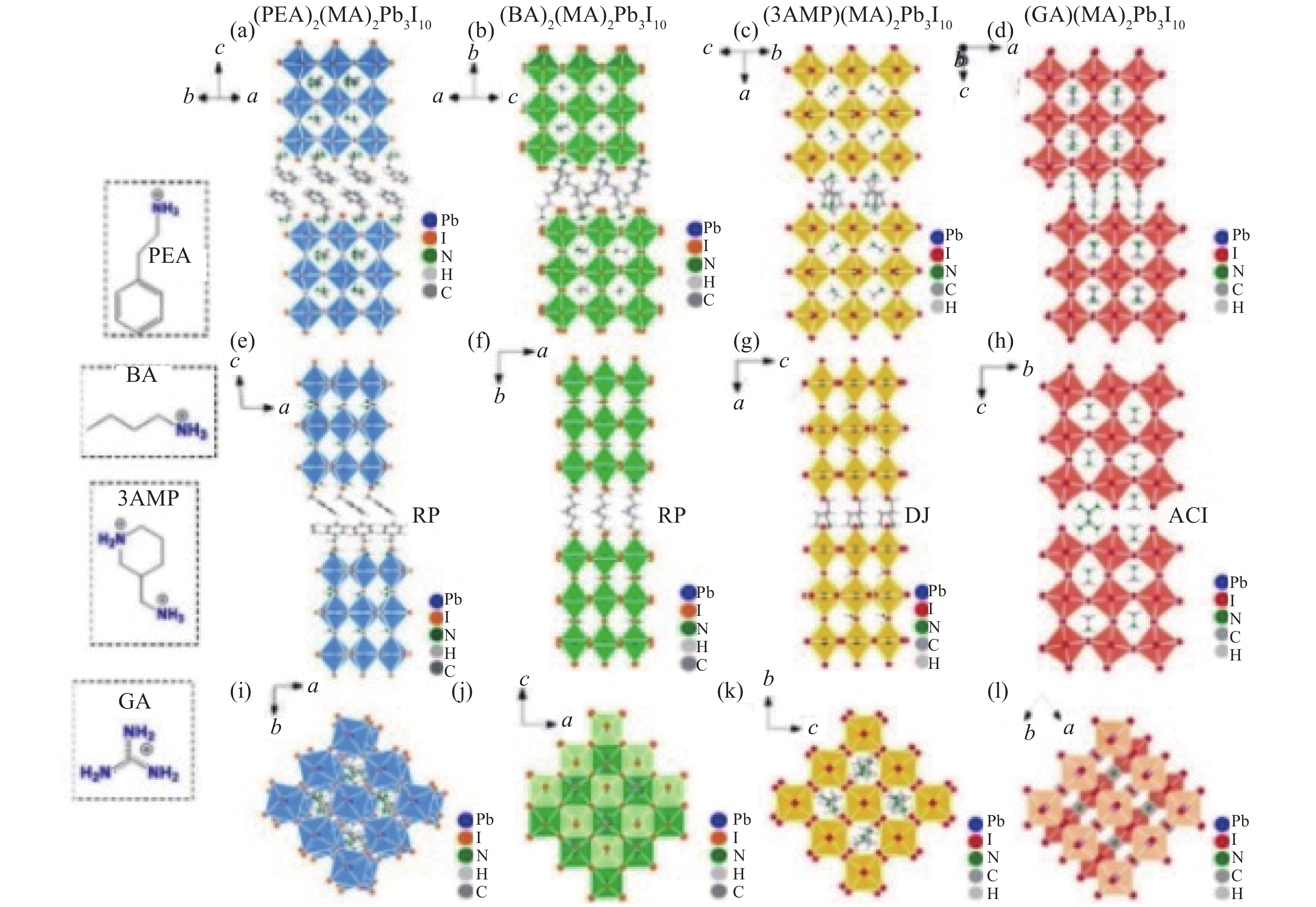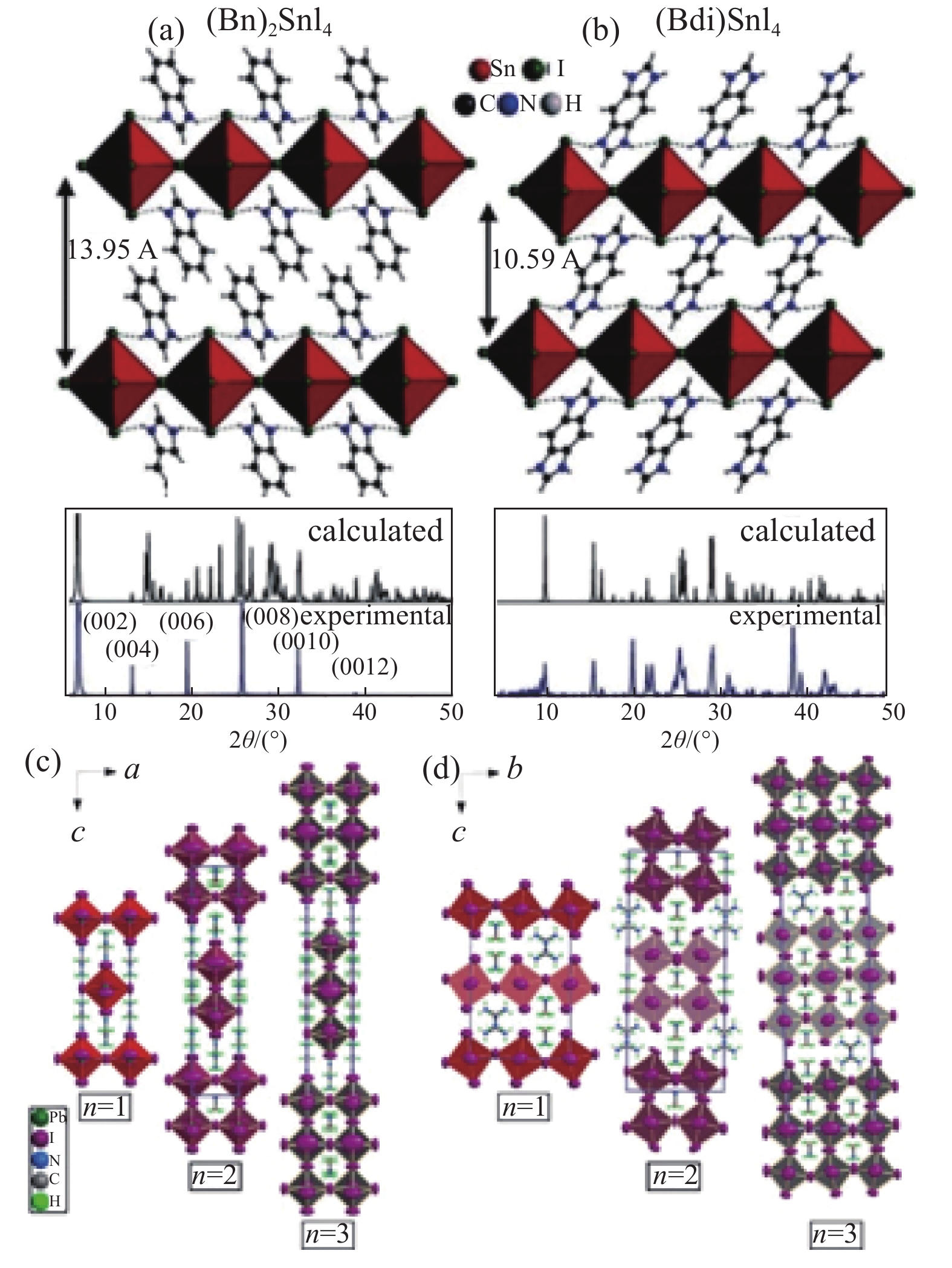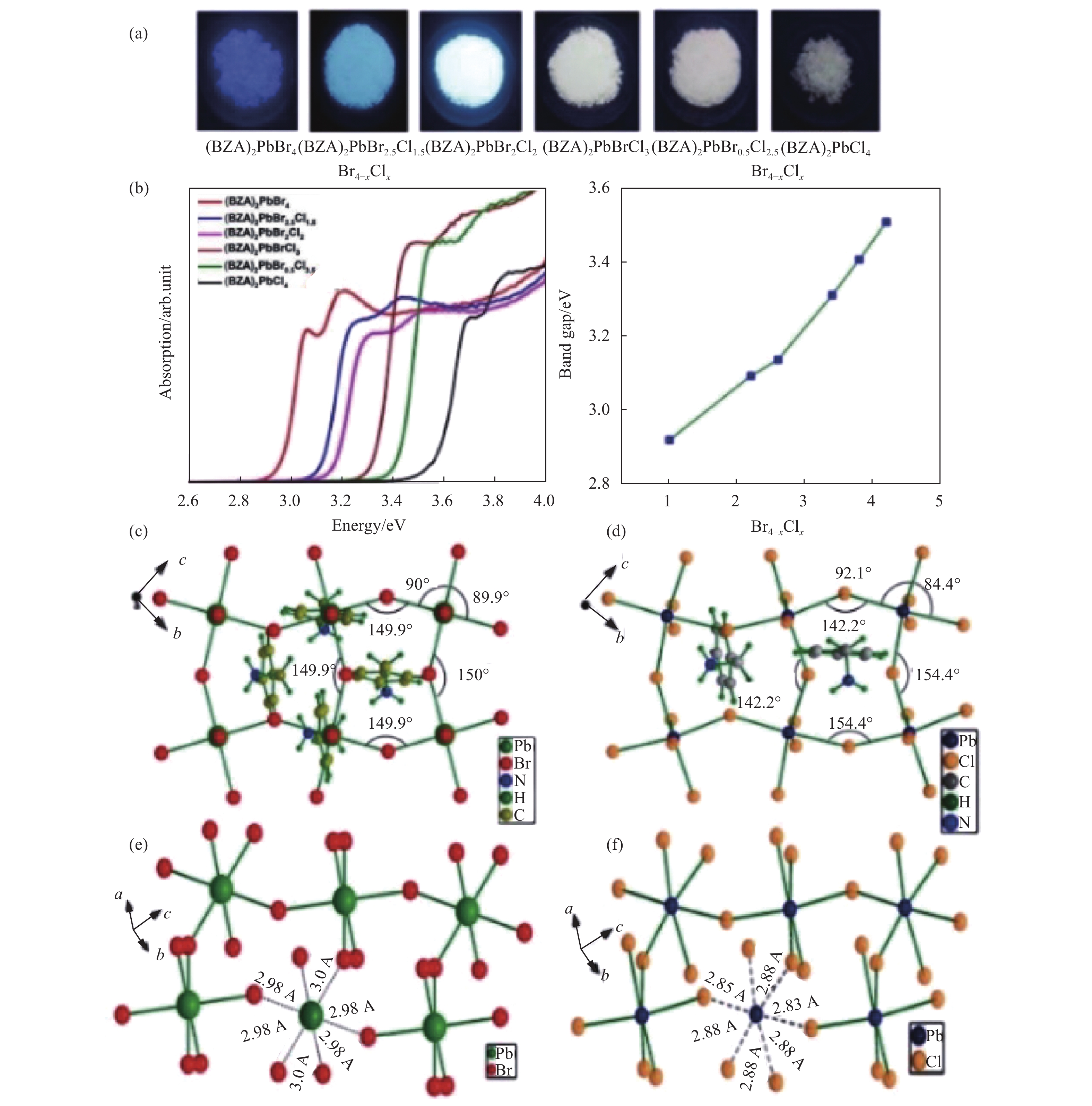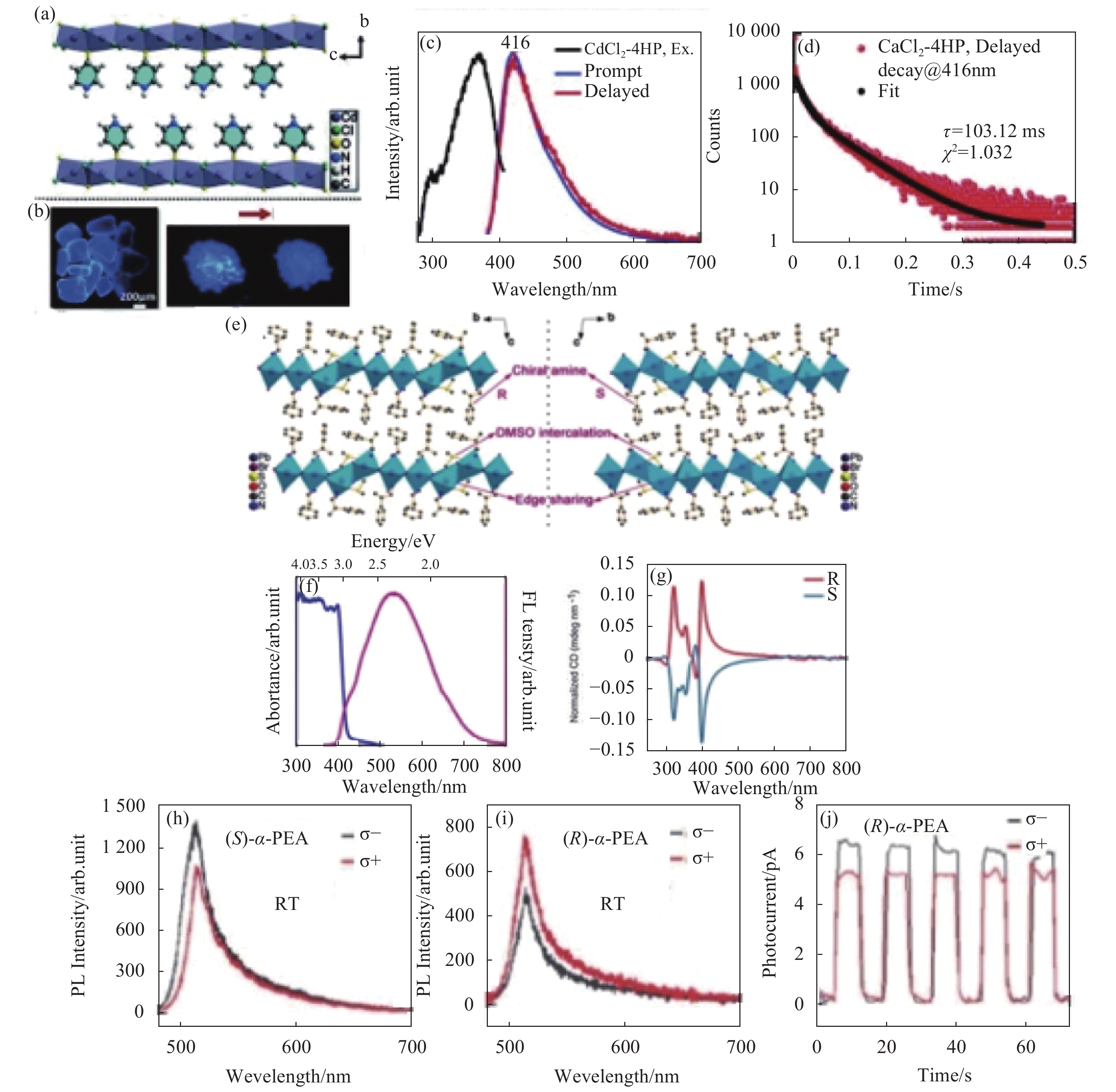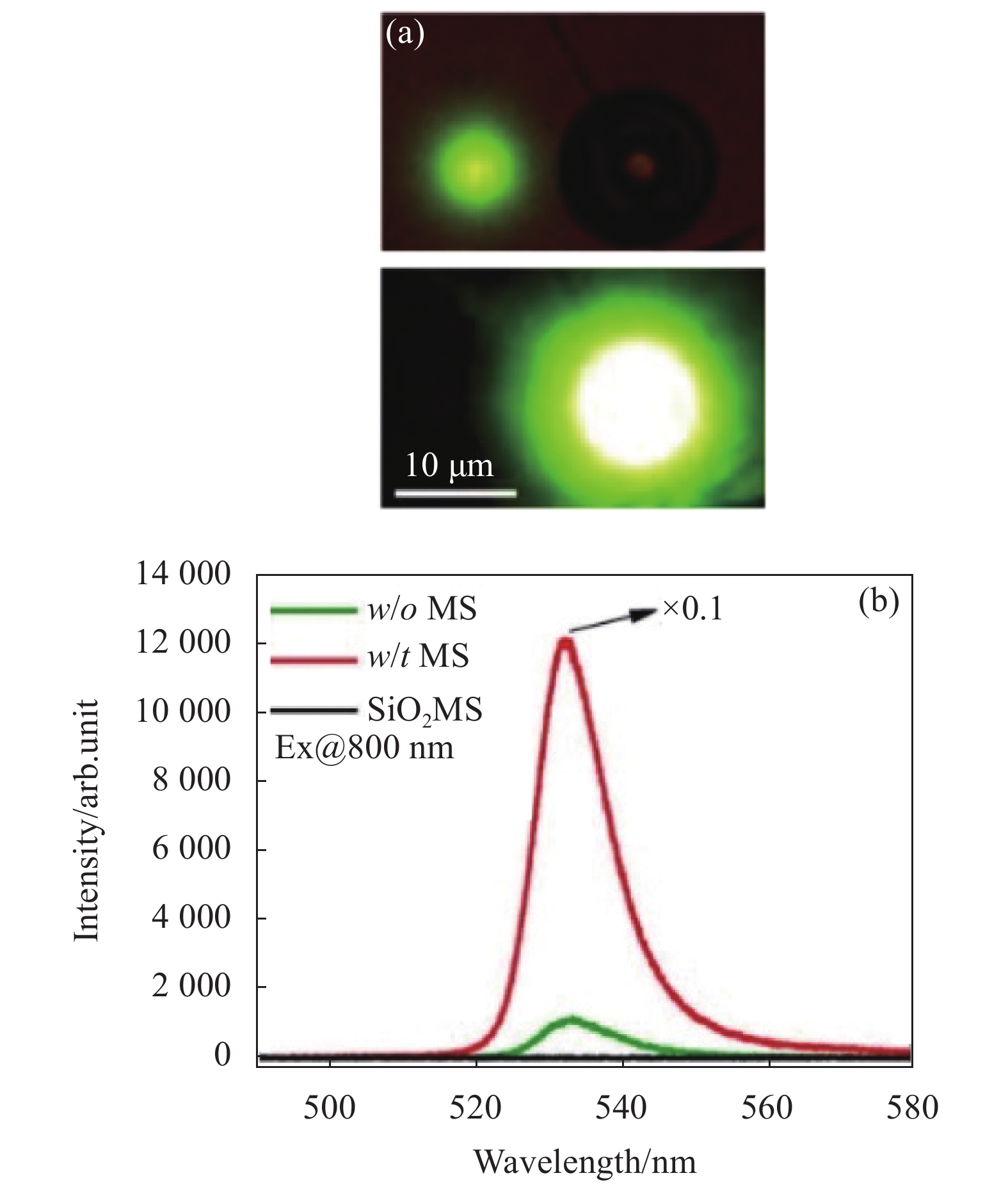-
自2004年单原子层状石墨烯问世以来[1],二维材料的研究得到了高速发展[2]。此后,过渡金属硫族化合物(TMDs)[3-5]、石墨炔(GD)[6-11]、六方氮化硼(h-BN)[12-13]、黑磷(BP)[14-15]等新型二维材料凭借各自优异的化学和物理特性,在光电子学[16]、光子学[17-20]、催化[21]、能量转换和存储材料[22, 23]等领域大放异彩。
不仅如此,这些二维材料很容易制备成相应的薄膜或纳米晶体,被广泛应用于光子学研究。这与它们具有超大的比表面积[24]、优异的鲁棒性[25]与机械灵活性[26]、高的表面灵敏度[27]、异质结构中的显著量子效应[28-29]、以及在范德华力作用下易堆叠[30]等优点密不可分。
钙钛矿结构材料,尤其是有机-无机杂化卤化钙钛矿,具有制备成本低、性能优异的特点,是一种高性能的半导体材料[31]。钙钛矿材料最具代表性的应用是作为性能优异的光伏材料[32-33],在过去十年里极大地提高了光电转换效率[34]。当杂化钙钛矿材料的维度从三维降低到二维,可以产生许多独特的性质,如大的激子结合能(>100 meV)、较长的载流子扩散距离、优异的光吸收能力、可控的载流子迁移率和高效的光致发光强度[35-36]。在这些结构中,重原子的引入与无机[BX6]八面体的刚性结构的协同作用促进了材料室温磷光(RTP)和热激活延迟荧光(TADF)的产生[37]。另外,可自由替换的有机配体和金属阳离子为钙钛矿材料提供了柔性的晶体结构、强大的抵抗性、可调带隙以及宽窄带发光的可能性。
非线性光学(NLO)研究物质与强光的强相互作用,它的发展对现代技术如全光开关[38]、远程通信[39-40]、信息处理和存储[41-42]等领域[43-45]起着关键作用。当入射光通过介质时,光与物质之间的相互作用会引起介质中电荷的相对位移,在外加光场下产生极化P(t),其定义如下[46-47]:
式中:E(t)代表外加光场的强度,χ(n)表示n阶极化率。χ(1)是线性光学极化率,表现为在普通光,如日照下的普通线性吸收、发射和折射[48]。非线性光学现象只能在激光等强光源下观察到[49-50]。强光所产生的极化作用可以诱导形成新的二次光场,还会引起相位和频率的变化等[51],因此,非线性光学效应是光子调节技术和集成光路技术[52]的关键,对于未来的光通信和光计算等技术[53]具有重要意义。
多种二维材料(如石墨烯[54-56],石墨炔[9, 57-59],TMDs[60-62],h-BN[63-64],BP[65-67],MOFs[68-70],COFs[71])均展现出优异的非线性光学效应。这些二维材料的出色非线性光学性能使其能够在频率转换、光整流、光调谐、光限幅和太赫兹生成及检测等许多重要领域中发挥作用。二维杂化钙钛矿材料的可极化性使其非常适用于非线性光学应用[53]。手性钙钛矿的研究极大推动了钙钛矿二阶非线性光学材料的发展[72]。为此,笔者讨论了二维钙钛矿体系的结构特征,总结了近年来它们在线性和非线性光学方面的主要研究进展,并对二维杂化钙钛矿非线性光学材料的研究现状及面临的挑战进行了分析。
-
最早发现的钙钛矿CaTiO3属于ABX3型的三维钙钛矿体系。通常A为小的有机或无机阳离子,B为过渡金属阳离子(如Pb+,Sn2+或Ag+),X为卤素阴离子(Cl−, Br−或I−),其基元为顶角共享的[BX6]八面体[73-74]。通常ABX3钙钛矿的构造遵循Goldschmidt公差因子,该因子决定了阳离子半径约为2.6 Å才能保证钙钛矿稳定的刚性三维骨架[75-76]。进一步的探索表明,阳离子A的细微变化将引起钙钛矿材料的结构、形态甚至尺寸的变化[77]。而当Goldschmidt公差因子t >1时,标准三维骨架很难成形,只能转换为低维(二维,1D,0D)钙钛矿材料。
具有分子式R2An−1BnX3n+1(R代表额外的大体积有机阳离子)的二维杂化钙钛矿[78]可以看作是从标准三维钙钛矿切割下来的子结构。通过沿不同的晶体学取向将三维框架切割,可以将二维层状钙钛矿分为(100),(110)和(111)衍生物(图1)[79]。反之,通过增加钙钛矿层的数量(n的值)也可实现从纯二维钙钛矿到准二维钙钛矿再到三维钙钛矿的转化(图2)[80-81]。

Figure 1. Derivation of 2D halide perovskites from the parental cubic perovskite lattice of 3D layered halide perovskites by cutting the latter along typical crystallographic planes: (100), (110), and (111)

Figure 2. Schematic illustration showing the crystalline structure of 2D perovskites (n = 1 and 2, where n represents the metal halide lattices), mixed-dimensionality perovskites and 3D perovskites (n = ∞)[80]
-
从结构上讲,(100)钙钛矿衍生物主要可分为R-P(Ruddlesden-Popper)相[82-83],D-J(Dion-Jacobson)相[84-86]和ACI相[87-88]层状钙钛矿,其特征通式分别为A′2An−1BnX3n+1,A′An−1BnX3n+1和A′AnBnX3n+1。这三种类型的二维钙钛矿之间的主要区别是无机组分堆积模式的不同。在(a,b)层平面中,D-J相相邻的无机双层采用更均匀的堆叠模式,表现出(0, 0)的面内位移[89]。而在R-P相和ACI相中可以观察到相对交错的堆叠模式,分别表现出(0.5, 0.5)和部分(0.5, 0)位移[86]。R-P相钙钛矿要求一对一价间隔阳离子插入每个八面体单元的夹层中(图3),而D-J相对应物只需要一个二价间隔阳离子。在R-P钙钛矿中,无机立方层可以更灵活、更自由地堆叠,因此其分子间的相互作用较弱。而层间间距的细微变化会对钙钛矿的光电性能产生极大的影响。例如,Iwan等人报道了基于对称的Bn (苯并咪唑鎓)和Bdi (苯并二咪唑鎓)阳离子的含锡钙钛矿[90]。Bdi2+阳离子中的两个咪唑环同时与上下层相互作用(图4(a)),将Bn2SnI4的层间距13.95 Å(1 Å=10−10 m)压缩为BdiSnI4的10.59 Å (图4(b))。与BdiMI4相比,这种层间间距的变化导致Bn2MI4晶体沿(001)方向优先生长,同时使得其电导率下降。

Figure 3. Structural comparison among the n = 3 crystal structures of the R-P phase, D-J phase, and ACI phase 2D perovskites: (A, E, I) (PEA)2(MA)2Pb3I10; (B, F, J) (BA)2(MA)2Pb3I10; (C, G, K) (3AMP)2(MA)2Pb3I10; and (D, H, L) (GA)(MA)3Pb3I10[89]

Figure 4. Structural drawings of the 2D perovskites [benzimidazolium]2SnI4 (a) and [benzodiimidazolium]SnI4 (b) Perpendicular to the stacking direction. The d-spacing between the single perovskite sheets indicated. The corresponding diffraction patterns of the 2D perovskites spin-coated on glass substrates are shown undernea[90]. View of the unit cells of the (GA)(MA)nPbnI3n+1 (n = 1−3) perovskites along (c) Crystallographic b-axis and (d) Crystallographic a-axis highlighting the ordered crystal packing of the GA and MA cations between the perovskite layers[88]
类似地,Li等人提出了两种二维D-J相卤化物钙钛矿(4AMPY)(MA)n−1PbnI3n+1和(3AMPY)(MA)n−1PbnI3n+1(MA =甲基铵,4AMPY = 4−(氨基甲基)吡啶,3AMPY = 3−(氨基甲基)吡啶)。更短的层间距使得(3AMPY)(MA)n−1PbnI3n+1钙钛矿的带隙更窄,通过量子阱结构容易分离的电子-空穴对使芳香族体系的激子结合能(Eb)变小[91]。
除了层间距之外,钙钛矿光电性能也与它们的层数和晶格扭曲密切相关。与三维结构钙钛矿相比,二维或准二维钙钛矿具有更大的Eg和更高的Eb,此外,二维平面中的量子限域效应和表面钝化提高了光致发光量子产率(PLQY)[92-94]。当n≥2时,随n值增大逐渐组装的无机八面体层形成了所谓“阱”[95]。
在ACI型钙钛矿(C(NH2)3)(CH3NH3)nPbnI3n+1中,其光学带隙在同一体系中随着层间距的改变呈单调性变化[88]。有趣的是,当层数为奇数(n = 1、3)时,该ACI钙钛矿属于中心对称Imma空间群;而层数为偶数(n = 2)时,则体系属于非中心对称的Bmm2空间群(图4(c)、(d))。这种变化源自晶体对称性因子的变化,n取偶数时出现镜面对称,n取奇数时出现滑移面。Yuan等人通过控制层厚n和纳米级杂化层状卤化物钙钛矿中的有机阳离子来调节发光颜色[96]。利用反胶束一锅法,层数n从1增加到无穷大,实现了其光致发光从深蓝色到绿色的红移。
通常八面体B-X-B二面角可估计晶格扭曲效应,较大的二面角通常对应于晶体骨架的较小扭曲[89, 97]。虽然钙钛矿晶格中的结构变形不如中间层对系统的影响大[89],但它在调节钙钛矿材料的性能方面仍然发挥着不可估量的作用。例如,由瞬态晶格扭曲产生的自陷激子(STE)会导致强烈的Stokes位移和超能带发射[97-99]。
最近,Jung等人制备了(BZA)2PbBr4-xClx (BZA =苄基胺,x = 0, 1.5, 2, 3, 3.5, 4),用于可调式固态发光[100]。钙钛矿(BZA)2PbBr4和(BZA)2PbCl4分别发出窄的蓝光和蓝绿光(图5(a)、(b))。对比不同的无机层的结构数据,相邻八面体的Pb-Br-Pb二面角几乎相同(149.9°和150.0°)(图5(c)),而Pb-Cl-Pb结合角急剧变化(142.2°和154.4°)(图5(d))。(BZA)2PbCl4的较大变形导致宽带发射。类似地,Zou等人报道了杂化钙钛矿(C6H5C2H4NH3)2PbBr4在不同压力下结构转变造成的宽带发射[101]。这在制造超高压环境中的光电探测器方面具有潜在价值。
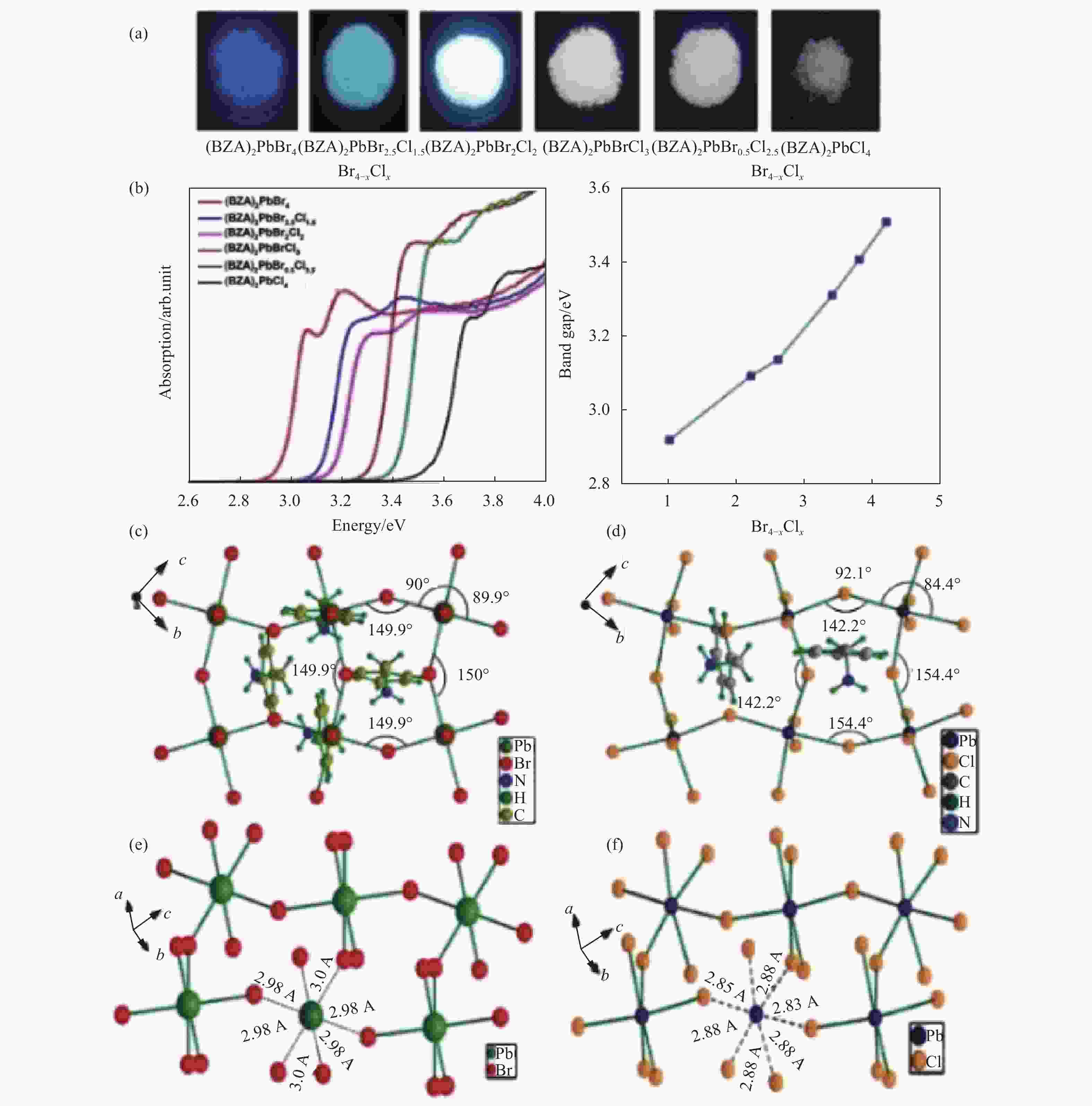
Figure 5. (a) Blue-light emission from (BZA)2PbBr4 powdered polycrystalline sample and white-light emission from the (BZA)2PbBr4−xClx (x = 1.5, 2, 3, 3.5, 4) perovskite series under UV excitation at λex = 365 or 254 nm; (b) Diffuse reflectance spectra and band gaps of the solid powder of the (BZA)2PbBr4−xClx perovskite (x = 4, 3.5, 3, 2, 1.5, 0) series. Structural geometry of (c) (BZA)2PbBr4 and (d) (BZA)2PbCl4. Bond distances of (e) Pb−Br and (f) Pb−Cl for PbBr62− and PbCl62−octahedra, respectively[100]
-
(110)取向的钙钛矿衍生物在三种类型的二维钙钛矿衍生物中相对较少,因为很少存在有机阳离子能够稳定该二维骨架。尽管如此,(110)取向的钙钛矿衍生物中的主要氢键相互作用可以同时起到稳定二维钙钛矿结构和影响生长的作用[102]。在可延展的无机骨架中,特殊的有机阳离子堆积促进了(110)取向钙钛矿扭曲结构的形成。实际上,(110)型钙钛矿是二维钙钛矿中弯曲度最高的钙钛矿衍生物,它们通式为A′2AmBmX3m+2,具有屋脊型的层式结构[103]。以屋脊型八面体晶格的“屋脊长度”为分类标准,(110)取向钙钛矿可分为“2×2”,“3×3”和“4×4”三个系列(图6(b))[104-105]。由于STEs效应,(110)取向钙钛矿的高度扭曲结构使它们在室温下即具有宽带发射效应[106-108]。

Figure 6. (a) Schematic plot of the Cl-addition-induced transformation from the 0D dimer phase of A3Sb2I9 to the 2D layered phase of A3Sb2ClxI9−x[104]; (b) Schematic representation of different structural types of corrugated (110)-oriented members of the 2D perovskite family[110]; (c) (111)-oriented perovskite family with general formula, An+1BnX3n+3, which can be obtained by cutting along the (111)-direction of the 3D parent structure. Panels (a) and (b) show the crystal structures of Cs4CuSb2Cl12 and α-Cs3Sb2Cl9. Cl and Cs atoms are depicted as green and purple spheres, respectively; Sb and Cu coordination polyhedra are shown in gray and blue, respectively[112]
(111)取向的钙钛矿可用通式A′2Ak−1BkX3k+3表示,可以认为是三维钙钛矿沿体对角线分裂而形成,这造成了M位的缺陷[89, 109]。A′2Ak−1BkX3k+3族由一价阳离子(R-NH3+, Cs+, Rb+)和VA族元素B (As3+, Sb3+, Bi3+)组成。它自发形成二维的角共享的分层钙钛矿(k=2)或零维的面共享二聚体簇(k=1),以稳定(B2X9)3−(图6(a))的立体构型并实现电荷平衡[110-111]。值得注意的是,当k> 2时,参与A′2Ak−1BkX3k+3构造的B阳离子应处于分数价态或不同价态的混合体。最近,Brenda Vargas合成了一个(111)取向的二维钙钛矿Cs4CuⅠSbⅢ2Cl12,(k = 3)[112],由角共享的[CuCl6]和[SbCl6]晶胞共同构成了主要骨架(图6(c))。
获取二维钙钛矿的柔性结构[113]需借助可控的合成方法,它们固有的弱离子键将起到决定性作用[114]。二维杂化钙钛矿的主要制备方法可分为溶液法和气相法[115]。通常,溶液方法具有多种优点,其处理过程十分经济,可以很容易通过改变溶液系统来获取钙钛矿的多种形态。2015年,Dou等人通过溶液晶体生长法制备了(C4H9NH3)2PbBr4二维超薄杂化钙钛矿[36]。借助三元溶剂系统(DMF,氯苯和乙腈),在基板上结晶出均匀二维片状材料,其最小厚度约为1.6 nm。Li等人研究了掺入Cl的浓度对(BA)2SnIxCl4−x (BA = n−CH3CH2CH2CH2NH3)钙钛矿的形貌、晶相和光学性质的影响[116]。随着Cl剂量的增加,二维钙钛矿的形态从片状转变为针状。同时,样品的发射峰呈现红移,相变温度也因较高的含Cl比而产生了急剧变化。
气相法可分为化学气相沉积法(CVD)[117]和范德华力外延法(van der Waals epitaxy)。尽管气相法通常价格昂贵并且需要较高的温度,但它们适用于合成具有更好的结晶度和更高纯度的二维钙钛矿。Chen等人结合溶液法和CH3NH3Br的CVD来合成二维同源钙钛矿(BA)2(MA)n-1PbnBr3n+1[118],所得的超薄大尺寸钙钛矿表现出优异的光电响应特性和出色的稳定性。Shi等人报道了通过范德华外延生长的高质量(C4H9NH3)2PbI4薄片,由于范德华相互作用,晶体厚度变薄,电子-声子耦合强度降低[119]。
-
由于引入了较大的有机阳离子,钙钛矿的原有三维结构排列受到破坏[120],最初的无机框架被向外延伸的有机阳离子双层夹在中间[121],给无机层带来了更高的电荷载流子迁移率和可调节的带隙[122-123]。因此,与三维同源物相比,二维杂化有机-无机钙钛矿表现出低介电系数和强激子结合能[114]。此外,有机组分在溶液加工过程中的可扩展性和可替换性也使二维钙钛矿具有了多种多样的优异光学性能和应用[94, 124-125]。
-
室温下的光致发光[126]是二维层状钙钛矿的重要光学现象,其本质是激子的辐射复合[127]。激子的自定域化加大了Stokes频移并扩大了宽带发光的范围,使二维钙钛矿成为应用于发光二极管[128-129],太阳能电池[130-131]和光电探测器[132-133]的重要材料。
2014年初,Karunadasa等人合成了一系列二维激发白光层状钙钛矿(EDBE)[PbX4](EDBE = 2, 2′-(乙二氧基)双(乙基铵); X = Cl,Br,I),光致发光量子效率(PLQEs)增长到9%[134]。恒定且稳定的辐射维持了三个月。对晶体结构的研究表明,由激子耦合产生的晶格变形和固有的自陷效应有助于连续且宽泛的白光发射[135-136]。根据此原理,可得到一系列二维杂化钙钛矿(C6H5C2H4NH3)2PbCl4[137],(CH3CH2NH3)4Pb3Br10−xClx[138], (C4H9NH3)2PbCl4[139],和(3APr)PbX4 (3APr = 3−氨基吡咯烷鎓)[102],并实现了室温条件下显著的白光发射。
长余辉发光材料一直被广泛关注,并在传感器、存储和安全领域中展现了潜在的应用价值[140]。此外,用于RTP发光体的系间窜越(ISC)过程和用于TADF发光体的反系间窜越(RISC)过程使得内量子效率(IQE)可达100%[141]。Yan等人开发出基于Cd的杂化卤化物二维钙钛矿CdCl2-4HP(4HP = 4−羟基吡啶)的特殊D-π-A结构,其在416 nm处有延迟荧光,寿命长达103.12 ms (图7(c)和7(d))[37]。量子限域效应、恰到好处的重原子效应和刚性层状结构(图7(a)),造就了罕见的深蓝色光发射(图7(b))和高的发射效率(63.55%)。类似地,Hu等人观察到的新型二维钙钛矿 (PEA1−xTTMAx)2PbBr4 (PEA = 苯乙铵,TTMA = 噻吩并[3, 2-b]噻吩-2-甲基铵)的磷光,寿命为0.2 ms,在室温下磷光产率为11.2%[142]。因为从三重态(T1)到基态(S0)的转变是禁阻的,TTMA有机分子在室温下不发磷光[143]。但是,当将TTMA有机分子插入钙钛矿的无机骨架中时,在无机组分中收集的能量转移到TTMA,就可以引发磷光。进一步的研究表明,混合阳离子将主客体系统用于钙钛矿可以有效地抑制非辐射复合,从而提高磷光寿命和量子产率[144-145]。
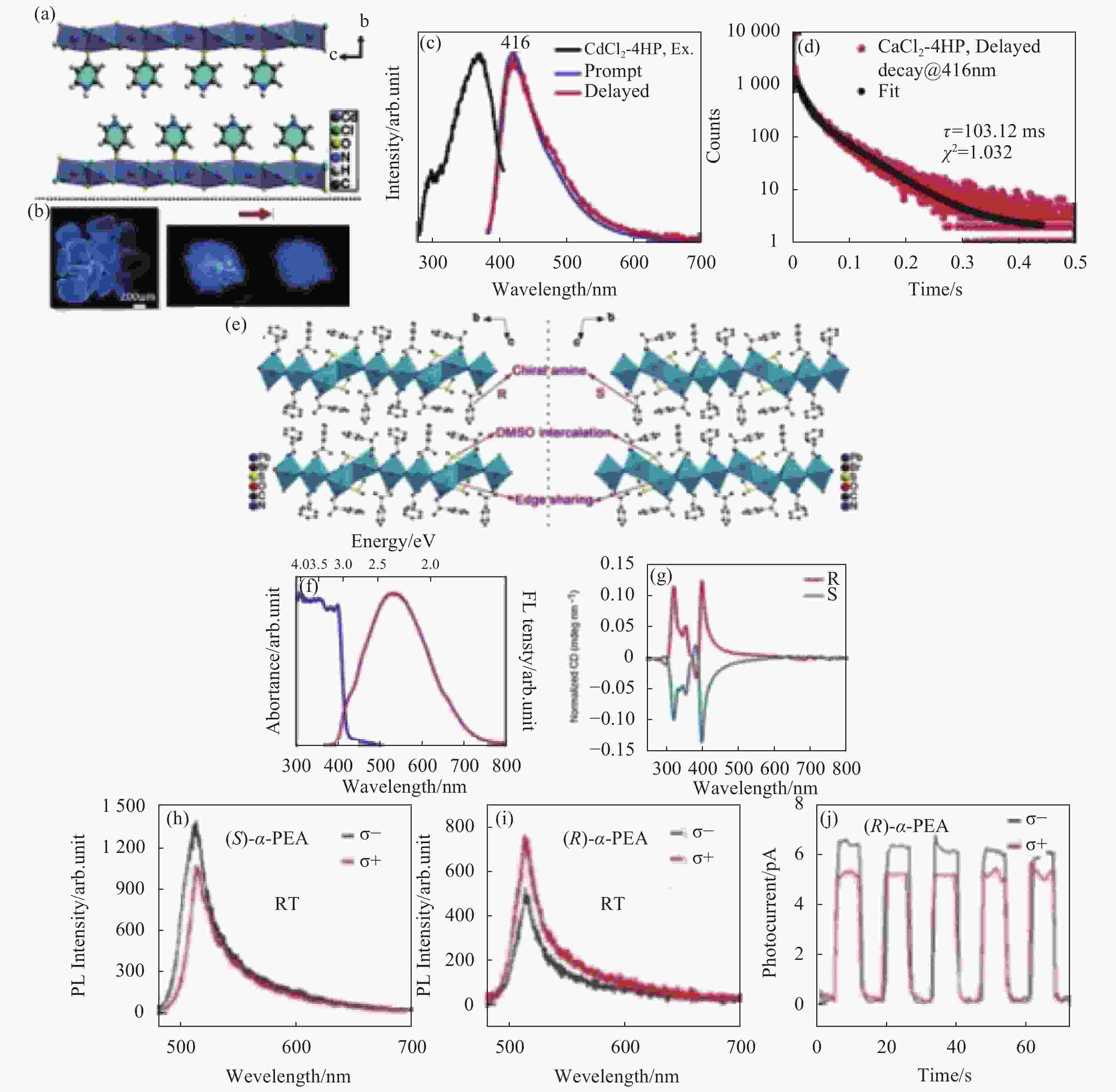
Figure 7. (a) Crystal structure ; (b) Fluorescence microscopy images of the CdCl2-4HP crystals; (c) Prompt (blue line) and delayed (red line) PL spectra of CdCl2-4HP excited under 365 nm at room temperature; (d) Time-resolved PL decay profiles (416 nm) of CdCl2-4HP at room temperature with a long lifetime of 103.12 ms[37]; (e) Crystallographic structure of the chiral perovskites as obtained from single crystal XRD measurements, showing the features of chirality, DMSO intercalation, and partial edge sharing; (f) Normalized DRS (diffusive reflectance spectrum) and fluorescence spectra of the as-prepared (R-MPEA)1.5PbBr3.5(DMSO)0.5 nanowires. Excitation wavelength: 400 nm; (g) Normalized CD spectra of the films spin-coated from DMF solutions of the R- and S-(MPEA)1.5PbBr3.5(DMSO)0.5 perovskite crystals. Average film thickness for both R- and S- (MPEA)1.5PbBr3.5(DMSO)0.5 is ~ 350 nm[148]; (h), (I) Circularly polarized PL emission of (S)-α-(PEA)2PbI4 and (R)-α-(PEA)2PbI4 crystals. (J) Optical switching characteristic of the (R)-α-(PEA)2PbI4 device under a 520 nm monochromatic σ− and σ+ illumination at a bias of −3 V[149]
钙钛矿中可替换的有机物阳离子不仅可以改变其带隙、发光颜色[142]、寿命、稳定性[146]和效率[147],而且还带来了新的光学性质。例如,当把手性有机物引入钙钛矿骨架中时,原始的几何中心对称性将被破坏。结果可以检测到圆二色性(CD)和圆偏振光(CPL)响应。2018年,Xu等人通过将手性胺结合到钙钛矿晶体结构中,报道了一种手性钙钛矿(MPEA)1.5PbBr3.5(DMSO)0.5[148]。其晶体结构表明,部分取代Br的DMSO溶剂分子插层于部分边共享的无机层的面上并与Pb2+形成配位(图7(e))。旋涂制备R-和S-(MPEA)1.5PbBr3.5(DMSO)0.5薄膜,发现二者均在325和405 nm光处表现出强烈的CD信号响应(图7(g))。此外,通过在相同的三元溶剂系统中进行液体扩散而生长的纳米线型晶体,隶属于相同的三斜晶系P1空间群。根据漫反射光谱,计算出光学带隙约为3.07 eV,同时,所制备出来的钙钛矿纳米线在400 nm光的刺激下显示了宽的包括整个可见光区域的发射范围(图7(f))。该纳米线型晶体发射的色度坐标为(0.40,0.42),即发出暖淡黄白光。
2018年,Long等人报道了手性二维钙钛矿中没有环境磁场的情况下3%的自旋极化光致发光[125],在传统三维钙钛矿中,该现象只有在5T的磁场下才能实现。在该手性二维钙钛矿中,手性配体(R-/S-甲基苄基溴化铵)的引入(n = 2)使得CD光谱中表现出明显的旋光性以及高效的CPL发光。此外,钙钛矿对映体的外消旋体的极化程度随外部磁场线性变化,实现了非手性钙钛矿的自旋控制。
近来,Li等人在57%HI溶液中,通过简便的溶液合成,无需退火制备得到橙色针状手性钙钛矿R/S-α-(PEA)2PbI4[149]。比较其左旋光(σ-)和右旋光(σ+),可发现在大约500 nm处的圆偏振光发射强度出现了显著的差异(图7(h),(I)),这表明这对手性钙钛矿对映体具有高效的发光选择性。将该手性钙钛矿进一步应用于CPL检测中,显示了出色的可重复性和光开关特性(图7(j)),并且展现了超高的外部量子效率(接近140%)。
除通用的发光材料外,二维杂化钙钛矿还与很多材料(Bi QDs[150],Te纳米片[151],Se纳米片[152],硫化锡[153]和BP[154])一样在光探测中展现出优异的性质。杂化钙钛矿具有高密度态的直接间隙,可以增强光与物质之间的相互作用[155]。它们通常具有较大的灵敏度[156],较高的开/关电流比[157]和超低暗电流[158]。例如,Tan等人制备了二维钙钛矿(C4H9NH3)2PbBr4晶体,并应用于光探器件[159]。用石墨烯薄膜覆盖后,该检测器表现出比其他典型二维材料更高的响应度(2100 A/W)。类似地,Qian等人报道了Sn基二维钙钛矿(PEA)2SnI4-xBrx (x = 1, 2, 3)的微米片,观察到了在470 nm的光照下(PEA)2SnI4的最大光响应度为3290 A/W,检测率为2.06 × 1011 J[160]。尽管杂化二维钙钛矿在响应度和探测性方面具有优越性,但它们的有效光谱范围通常比Bi QDs、Se纳米片、SnS等二维材料窄。
-
经典的和新兴的二维材料(例如石墨烯,BP[161],SnS[162],和Se纳米片[163])均已应用于非线性光学。例如,石墨烯具有宽带和强度依赖的非线性光学吸收[164],以及由活性磷原子组成的单元素二维各向异性材料黑磷[161, 165]从可见光到[18, 166]中红外均表现出良好的宽带三阶非线性光学效应(四波混频和三次谐波产生等)以及与尺寸相关的非线性光学现象[65]。此外,黑磷的非中心对称晶格结构[167]使它可以直接用于二阶非线性光学。SnS层状材料具有出色的化学和热稳定性[168]以及可调节的带隙和奇偶量子限制[169],具有优异的三阶非线性光学响应,少层的SnS被用于全光谱信息转换,全光开关[162]和SA[170]。此外,理论研究表明,单层SnS独特的非中心对称C2v (mm2)点群使其具有SHG敏感性[171]。三方晶系的二维Se纳米片显示出了良好的非线性光学性质,这可归因于其大的表面积和与尺寸相关的带隙[163],其在饱和吸收体与超快光子学方面表现出了大的潜力。
与上述二维材料相比,二维杂化钙钛矿丰富的化学多样性和结构多样性赋予它们在非线性光学应用的多项优势[53]。其产生的多重量子阱(MQW)结构将增强非线性光学特性[172]。此外,这些层状二维杂化钙钛矿材料的晶格结构和形貌特征十分丰富,可通过不同的途径调整。与其他经典二维材料制造的低产率、[173]低质量[174]和严格的制备条件[175-176]相比,通过溶液或气相途径可以轻松地获得高质量且均匀的二维钙钛矿晶体。此外,有机阳离子在二维杂化钙钛矿中的易取代性为非线性光学的调节提供了便利条件。这些优势推动了二维杂化钙钛矿非线性光学的发展。
-
1961年,Franken等人[177]首次从石英晶体中观察到了SHG现象,这一特殊的现象拉开了非线性光学研究的序幕。之后,随着新型非线性光学材料的快速发展,更多的非线性光学效应逐渐被人们所发现。直到现在,SHG仍是重要的非线性光学现象[178-180]。然而,由于电偶极子近似推导的二阶非线性光学极化率在中心对称结构中几乎为零,二阶非线性光学效应在中心对称晶体中是禁阻的[181-182]。因此,二阶非线性光学只能存在于非中心对称的体系中[183-184]。
大多数二维钙钛矿由于空间结构对称性不具有二阶非线性光学活性。Wang等人提出了一种发白光的二维杂化钙钛矿(2meptH2)PbBr4 (2mept表示2-甲基-1, 5-二氨基戊烷)[185]。除了发射范围宽和PLQY高以外,在1064 nm激光(Nd:YAG)激发下它还表现出SHG响应(表1)。单晶X射线衍射分析表明该钙钛矿属于极性Cc(No. 9)空间群,该空间群由连续的无机八面体相互挤压产生,有助于得到显著的偶极矩(0.3354×10−29 C m-1)。
Chemical formula Metal Halogen Organic ligand Phase NLO property Reference (2meptH2)PbBr4 Pb Br 2-methyl-1,5-diaminopentane R-P SHG 185 (C4H9NH3)2CsPb2Br7 Pb Br C4H9NH3 R-P SHG 189 [CH3(CH2)3NH3]2(CH3NH3)Pb2Br7 Pb Br CH3(CH2)3NH3, CH3NH3 R-P SHG 191 (BA)2(EA)2Pb3I10 Pb I n-butylammonium, ethylammonium R-P SHG 192 [(C6H5CH2NH3)2]PbCl4 Pb Cl C6H5CH2NH3 R-P SHG 199 R/S-(MPEA)1.5PbBr3.5(DMSO)0.5 Pb Br methylphenethylamine - SHG 148 [R/S-LIPF]2PbI4 Pb I R/S-1-(4-chlorophenyl)ethylammonium R-P SHG 200 (C6H5C2H4NH3)2PbI4 Pb I C6H5C2H4NH3 R-P THz 203 (CH3(CH2)3NH3)2(CH3NH3)n-1PbnI3n+1 Pb I CH3(CH2)3NH3, CH3NH3 R-P THG 207 (C4H9NH3)2PbBr4 Pb Br C4H9NH3 R-P THG 209 (C4H9NH3)2PbI4 Pb I C4H9NH3 R-P THG 209 (C4H9NH3)2(CH3NH3)Pb2I7 Pb I C4H9NH3, CH3NH3 R-P THG 209 (C4H9NH3)2(CH3NH3)2Pb3I10 Pb I C4H9NH3, CH3NH3 R-P THG 209 (C4H9NH3)2(NH2CHNH2)Pb2Br7 Pb Br C4H9NH3, NH2CHNH2 R-P 2PA 213 (PEA)2PbI4 Pb I phenethylamine R-P 2PA 214 (BA)2PbI4/(BA)2MAPb2I7) Pb I n-C4H9NH3 R-P 2PA 215 (PEA)2(MA)4Pb5Br16 Pb Br phenethylamine, methylammonium R-P 2PL 217 (C4H9NH3)2PbBr4 Pb Br C4H9NH3 R-P 3PA 226 (OA)2PbBr4 Pb Br octyl ammonium R-P 5PA 227 (C6H5C2H4NH3)2PbI4 Pb I C6H5C2H4NH3 R-P SA 234 (BA)2(MA)n−1PbnBr3n+1 Pb Br n-C4H9NH3, methylammonium R-P SA 235 Table 1. 2D perovskites for NLO
铁电性作为材料中的重要特性,与非对称性密不可分,因而铁电性也通常伴随二阶非线性光学[186-187]。值得注意的是,有机阳离子的高度自由运动为铁电性的产生提供了更多的机会[188]。Luo等人将脂肪族胺合金化,利用经典的三维无机钙钛矿CsPbBr3合成,破坏了初级晶体的对称性[189],生成的(C4H9NH3)2CsPb2Br7具有显著的铁电性(约4.2μC/cm−2)和高于BaTiO3的居里温度(Tc = 412 K)。从室温到Tc,随着另一钙钛矿相(图8 (b),(c),(d)和(e))中不对称元素的减少,它表现出与温度相关的SHG响应(图8(a))。实际上,SHG检测是识别不对称性或不对称和对称性之间特殊相位转换的有效且灵敏的途径[190]。

Figure 8. (A) Temperature dependent SHG signals of (C4H9NH3)2CsPb2Br7. Inset: Crystal structures of (C4H9NH3)2CsPb2Br7 at different temperatures. At 293 K: (b) viewed along the crystallographic b-axis and (c) the perovskite framework. The arrows indicate the relative displacements along the crystallographic c-axis. At 420 K: (d) highly symmetric structure packing and (E) perovskite framework[189]
Sun等人[191]设计了一种高度偏振敏感的二维杂化钙钛矿铁电体[CH3(CH2)3NH3]2(CH3NH3)Pb2Br7,并用于检测短波偏振光[191]。P-E磁滞回线记录表明,在318 K时它具有3.6 μC/cm2的超强自发极化(Ps),可检测到的SHG响应显示出在室温下稳定的SHG强度约为0.4×KDP。该钙钛矿铁电体还显示出较强的二色性比(Icph/Iaph≈2.0),同时具有出色的灵敏检测率(约109Jones)和短波区域的灵敏响应率(约20 μs)。该课题组还研究了在高温下反铁电二维多层杂化钙钛矿((BA)2(EA)2Pb3I10 (BA =正丁基铵,EA =乙基铵)[192]。高度依赖温度的SHG活性证实了该钙钛矿中存在非中心对称结构。P-E磁滞回线验证了铁电和反铁电的存在,该性质伴有Ps为5.6 μC/cm2 (室温)的双轴铁电和高居里点(约363 K)。同时,出色的储能效率(65%-83%)赋予了其高效的储电潜力。此外,压电材料也与材料的非中心对称性和非线性光学密切相关[193-195]。然而,大多数二维钙钛矿压电材料是全无机的。例如,CsLaNb2O7[196]、RbBi2Ti2NbO10[197]、CsBi2Ti2TaO10[197]和LiRTiO4[198](R代表稀土元素)压电材料均具有清晰的SHG信号,表现出特征的不对称性。
因为层数可灵活变化且能替换各种阳离子,二维钙钛矿往往比其他二维层状材料更容易进行构造的调整。因此,常见SHG响应随钙钛矿极化的改变而变化。最近,Wei等人使用SHG检测方法,观察了具有极性空间基团(Cmc21)的二维杂化钙钛矿[(C6H5CH2NH3)2]PbCl4纳米片中的范德华(vdW)相互作用[199]。如图9(a)和图9(b)所示,沿晶体b轴和c轴极化的SHG效应以及SHG强度的各向异性表明,由于vdW相互作用的微小变化,随着纳米片厚度的减小,信号强度有所衰减。

Figure 9. (a) Polar SHG intensity plots of the 2D [(C6H5CH2NH3)2]PbCl4 perovskite nanosheets. (b) SHG intensity anisotropy (Ic-axis/Ib-axis
) dependent on the thickness of the measured nanosheets[199] 如前所述,手性官能团的引入可以诱导二维钙钛矿形成非中心对称空间构型,促进二阶非线性光学效应的产生与应用。例如,二维手性钙钛矿纳米线R-(MPEA)1.5PbBr3.5(DMSO)0.5显示出在多种波长的激光下泵浦的突出SHG信号(图10(a))。它具有较高的二阶NLO系数(deff约0.68 pm / V),激光损伤阈值为8.6×104 W/cm2。进一步的偏振依赖的SHG测量(图10(c))结果表明,手性钙钛矿在线性偏振激光下(图10(b))显示出高达96.4%的大偏振比,在圆偏振光泵浦下(图10(d))也显示出清晰的非线性光学圆二色性。

Figure 10. (a) Normalized NLO spectra of a (R-MPEA)1.5PbBr3.5(DMSO)0.5 nanowire pumped at various wavelengths; (b) SHG intensity from a horizontally oriented (R-MPEA)1.5PbBr3.5(DMSO)0.5 nanowire as function of the linear polarization angle as tuned by the λ/2 plate;(c) Schematics of the NLO measurements; (d) SHG intensity from the nanowire as function of the rotation angle of the λ/4 plate. The pump was left-handed circularly polarized when the rotation angle was 45° and 225°, and was right-handed circularly polarized when the rotation angle was 135° and 315°, as indicated by the arrows [148]
之后不久,Xiong等人[200]将手性阳离子对映体(R/S-LIPF,LIPF = 1-(4-氯苯基)乙铵)与二维碘化铅钙钛矿结合,得到同时具有铁电和SHG响应的二维钙钛矿材料[200]。这对对映体是通过简单的分子调制在室温下极性P1空间群中结晶的,这表明了自发极化的存在(计算值约为13.96 μC/ cm−2)。R-LIPF(Tc(R) = 483.0 K)和S-LIPF(Tc(S) = 473.2 K)钙钛矿的相变温度Tc明显不同,这与一般对映异构体不同。从SHG光谱来看,R/S-LIPF显示出适中的SHG强度(大约是KDP参考的一半),当温度上升,接近Tc时强度逐渐衰减。压电响应力显微镜(PFM)的磁滞回线显示了R-LIPF薄膜具有相当大的局部矫顽电压响应(≈112 V),这解释了其显著的铁电性能和可转换的极化效应。
由二阶非线性光学材料产生的太赫兹(THz)辐射(集中在0.1~10 THz频率范围内)[201-202],已经迅速发展并应用于通信、检测和传感设施。但是在实际应用上,很少通过二维钙钛矿生成和调制THz辐射。2017年,Chanana等人[203]通过沉积在半导体衬底上的二维杂化钙钛矿(C6H5C2H4NH3)2PbI4 (PEPI)完成了THz辐射的选择性调制[203],可以通过改变层数灵活地调节多层钙钛矿的带隙和激子吸收带。与纯硅半导体相比,钙钛矿/硅晶片上的宽带太赫兹吸收明显优越[204]。
-
三阶非线性光学不受非中心对称结构的限制,因此,更多的二维材料可以用于三阶非线性光学[205-206]。Saouma等人通过三次谐波产生(THG),探索了二维R-P钙钛矿(CH3(CH2)3NH3)2(CH3NH3)n−1PbnI3n+1 (n = 1−4)的三阶非线性光学[207]。就整个红外(IR)的THG系数而言,它的表现优于其三维对应物MAPbBr3和参考材料AgGaSe2,χ(3)范围为(2.6 ± 0.5)×10−11 esu到(5.6 ± 1.0)×10−11 esu。随着钙钛矿尺寸的减小,激光诱导的损伤阈值也得到了改善。此外,这些二维钙钛矿都具有对光学损伤的高弹性。一般认为二维R-P钙钛矿中的单量子阱结构有利于增强三阶非线性光学[208]。Abdelwahab等人从四个二维R-P钙钛矿(C4H9NH3)2PbBr4(Brn=1),(C4H9NH3)2PbI4(In=1), (C4H9NH3)2(CH3NH3)Pb2I7(In=2)和(C4H9NH3)2(CH3NH3)2Pb3I10 (In=3)的单晶中机械剥离纳米薄片[209]。这些二维R-P钙钛矿纳米片几乎在整个可见光范围内都能产生强THG信号。(C4H9NH3)2(CH3NH3)Pb2I7 R-Ps的三阶非线性光学极化率χ(3)为1.12 × 10−17 m2 V−2,远高于常规二维材料[210]。
双光子吸收(2PA)也是重要的三阶非线性光学效应,其强度和深度呈二次关系[211]。该现象有望提高太阳能电池的光捕获能力[206]和光探测器的灵敏度[212]。Luo等人报道了具有突出双光子吸收效应的铁电杂化钙钛矿(C4H9NH3)2(NH2CHNH2)Pb2Br7单晶[213]。在[Pb2Br7]∞八面体中,独特的双层堆叠紧紧限制了载流子移动。通过Z扫描技术测定了其双光子吸收系数为5.76×103 cm GW−1,高于传统的全无机钙钛矿。DSC曲线揭示了可逆的(322 K/318 K)铁电相变,并显示了3.8 μC/cm−2的自发极化。为了增强2PA的光致发光,Lu等人设计了一种由SiO2微球组成的复合结构,并将其转移到均匀的二维钙钛矿片中[214]。通过使用透明胶带,从制备的(PEA)2PbI4钙钛矿薄膜中机械剥落这些二维钙钛矿片,然后覆盖上均匀分散的介电微球。二维钙钛矿薄片中的混合电介质结构不仅使泵浦激光集中,而且抑制了非辐射损耗。在微球的协同作用下,2PA诱导的光致发光发射比初始提高了两个数量级(图11)。除了均质钙钛矿晶体以外,二维钙钛矿中的异质结构也有望展现出优异的非线性光学性能。Wang等人探索了(BA)2PbI4/(BA)2MAPb2I7) (BA = n−C4H9NH3)异质结构的非线性光学特性[215]。将800~1200 nm的多光子诱导光致发光(MPL)与非线性透射率测量相结合,可以测定二维钙钛矿异质结构比纯(BA)2PbI4 (4.56 cm MW−1)和(BA)2MAPb2I7 (6.25 cm MW−1)具有更大的2PA系数(44 cm MW−1)。另外,设计的异质结构在红外波段中有10−7 A W−1的高响应度。该材料优异的非线性光学特性可能是源于钙钛矿异质结构中通过天线效应(antenna-like effect)进行的非辐射能量转移。除了双光子吸收外,双光子发光(2PL)也是在生物成像等实际应用中有价值的非线性光学效应[216]。Zhu等人[217]通过巧妙的反溶剂处理方法合成了一种准二维钙钛矿(PEA)2(MA)4Pb5Br16 (n = 5)[217]。在980 nm的连续波(CW)激发下,直接通过光学激发间隙态可以观察到双光子上转换发光。但是,当n小于5时,2PL响应变得不再明显。

Figure 11. (a) 2PL images of the perovskite flake without (top panel) and with (bottom panel) SiO2 microsphere under an excitation power of 0.1 mW, respectively; (b) 2PL spectra for a bare perovskite flake (w/o MS, green curve) and a perovskite-microsphere hybrid dielectric structure (w/t MS, red curve). The SiO2 microsphere shows no emission within this waveband (black curve)[214]
为了增强多光子吸收(MPA)截面(η × σn,η和σn分别代表光致发光量子产率和截面),更高阶的非线性光学效应,例如三光子吸收(3PA)[218],四光子吸收(4PA)[219],甚至五光子吸收(5PA)[220]也相继出现[221-222]。对于高分辨率成像、光限幅、泵浦激射等方面的应用,多光子荧光需要更大的穿透深度、更小的背景荧光和更低的光损伤[223-225]。最近,Ji等人比较了多层钙钛矿(C4H9NH3)2PbBr4与三维钙钛矿3PA系数的差异[226]。根据二维激子量子微扰模型,在约1000 nm的激光激发下,3PA系数应为2~7 cm3 GW−2。三光子激发光致发光(3PL)与理论推测非常吻合,证实了二维激子在增强3PA系数中的关键作用。此外,该理论还推论出,由于最终激子态的线宽低(< 1 meV),低温会将3PA系数提高至少2个数量级。
传统的半导体材料或有机晶体通常很难达到高的4PA或5PA非线性光学截面。Chen等人[227]提出了一种自制的核-壳卤化物钙钛矿胶体纳米晶体,该晶体包含三维MAPbBr3核和(OA)2PbBr4壳(OA = 辛基胺),具有超高的5PA系数[227]。包裹在核上的(OA)2PbBr4壳层为MAPbBr3提供了更强的量子限域作用,并实现了表面钝化,与裸露的MAPbBr3纳米晶体相比,σ5和荧光量子产率都得到了提升[228-230]。使用波长为800 nm的Z扫描测量[231]研究该核-壳多维钙钛矿,其ησn约为10−136 cm10 s4 photon−4,比报道的有机染料高出9个数量级[231]。
二维钙钛矿优异的非线性光学特性和光学稳定性已将其应用扩展到超快激光光学。激光发射源自饱和吸收(SA),饱和吸收体可以选择性滤出低强度光[232]。与三维钙钛矿纳米片产生脉冲不同[233],Hong等人制备了二维杂化钙钛矿(C6H5C2H4NH3)2PbI4(缩写为PEPI)微晶薄膜,用于光纤激光器的超快锁模[234]。基于PEPI饱和吸收体的作用,在异常情况下,孤子脉冲(381 fs)覆盖了C和L波段,在正常色散状态下,耗散孤子脉冲在1561.2 nm的中心形成,稳定脉冲持续时间为3.4 ps,具有可靠的重复性。此外,可以通过在C波段和L波段改变光增益调节激光波长。Fu等人在密闭溶液中通过PDMS(聚二甲基硅氧烷)模板途径,以二维钙钛矿(BA)2(MA)n−1PbnBr3n+1为基础设计了大面积微环激光器阵列[235]。在放大自发发射(ASE)过程中,发现n = 6微环具有112 cm−1的较高增益系数(G),并且具有13.6 μJ cm−2的低阈值通量,其性能要比以前报道的三维钙钛矿类似物[236-237]高出许多。在回音壁模式下,均匀的薄膜谐振腔获得了约2600的品质因子。
-
作为一种高性能的半导体材料,低成本和简单的制造工艺已经使二维有机-无机杂化钙钛矿具备了诸如石墨烯、TMD和BP等传统的二维半导体材料的优势。同时,有机阳离子的种类比无机阳离子丰富,这些有机阳离子的多样性使得二维杂化钙钛矿在调节层间距离和结构变形方面具有很高的自由度和灵活性。独特的自然形成的多量子阱效应导致其具有巨大的激子结合能和更高的稳定性,而层数n在调节钙钛矿的带隙中起着至关重要的作用,使其成为了光子学和光电子学应用的热点。此外,手性有机官能团的引入突破了传统杂化钙钛矿中的空间对称性限制,扩展了二维钙钛矿在二阶非线性应用中的新途径。尽管如此,该领域的研究和技术仍处于起步阶段。例如,THz的产生、检测和调制、光合频产生(SFG)、光差频产生(SFG)和Kerr效应的研究仍值得进一步探索。还值得一提的是,等离子体纳米结构具有非凡的光学特性,可以通过等离激元激发来增强二维杂化钙钛矿中的光-质相互作用[238]。通过掺入等离子体金属纳米粒子,钙钛矿-等离子体半导体中光学和光电性能将显著提高[239-240]。等离子体效应带来的增强非线性特性已经扩展到非线性等离子体研究的新领域。在具有简单的等离子体纳米粒子的二维钙钛矿中,也已经观察到SHG、THG、多光子吸收或发射等的增强。此外,等离激元效应显示出了其在设计制作低功率、小尺寸和快速响应的光学设备方面的巨大潜力[241]。
但是,二维钙钛矿领域也存在一些不容忽视的短板,包括在热、光和湿度等刺激下的不稳定性,以及源自重金属的毒性问题。尽管插入有机阳离子可以增强二维钙钛矿的抗性和适应性,但它本质上不能解决这些问题。与其他二维材料不同,即使它们的非线性光学性质十分适合生物成像和生物传感[242-244],但本身高含量的重金属和卤元素阻碍了它们在生物医学领域的应用。为了减轻含铅钙钛矿毒性的影响,一些关于无铅杂化钙钛矿的研究大量涌现。但是,这些二维无铅杂化钙钛矿的非线性光学研究仍处于起步阶段。因此,二维钙钛矿中的不稳定性和毒性是阻碍研究和工业发展的主要因素。此外,二维钙钛矿异质结构的出现也为改善性能提供了一种新方法。BP、TMDs、石墨烯等的材料的加入可形成电荷载流子传输和光电门效应的可调屏障,以优化原始钙钛矿材料的性能(例如光电探测器或光电晶体管的灵敏度)并激发其纳米光子功能。高质量、长期稳定、环境友好、效率更高的二维有机-无机杂化钙钛矿将为光子学、电光、光电和其他重要的跨学科领域中综合化应用开辟新的道路。
Recent progress in nonlinear optics of 2D organic-inorganic hybrid perovskites (Invited)
doi: 10.3788/IRLA20201063
- Received Date: 2020-10-12
- Rev Recd Date: 2020-11-25
- Available Online: 2021-01-14
- Publish Date: 2020-12-24
-
Key words:
- 2D hybrid perovskites /
- quantum-well structure /
- structure tunability /
- nonlinear optics
Abstract: Since the advent of perovskite materials, the numerous organic-inorganic hybrid perovskites have thrived vigorously over the decades. Two-dimensional (2D) organic-inorganic hybrid perovskites containing prototypical inorganic octahedron frames and diverse organic cations feature characteristics of intrinsic quantum-well structures and intriguing optoelectronic properties, and have therefore attracted research attention intensively for their optical applications in light emitting, sensing, modulation, photovoltaic cells and telecommunication devices. The low-cost and solution-processed fabrications as well as the alternative organic spacer cations endue 2D hybrid perovskites with flexible layer distances, number of layers, and variable lattice distortion, leading to effectuate the adjustable frameworks as well as higher tunability in optical and photonic applications. In particular, they also demonstrate distinguished and appealing nonlinear optical (NLO) characters whether in the second-order, third-order NLOs or the higher-order NLOs such as second-harmonic generation (SHG), terahertz generation, two-photon absorption (2PA), and saturable absorption (SA), three-photon absorption (3PA), etc., under the excitation of laser pulses. Here, we discuss on the construction of the various 2D hybrid perovskites with different structural features. Furthermore, some representative properties and applications of these 2D hybrid perovskites are discussed in both linear and nonlinear optical regimes. Lastly, the status quo and challenge of 2D hybrid perovskites are elevated, and the future developments of 2D hybrid perovskites is prospected.



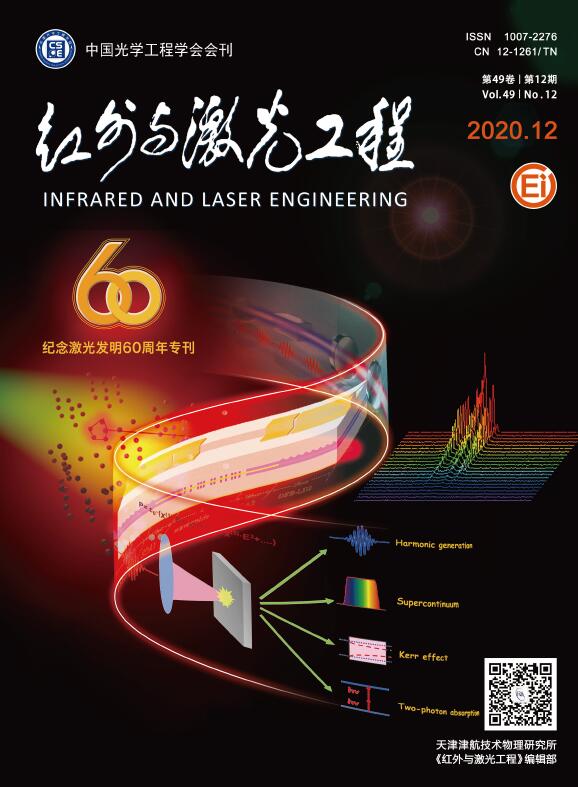






 DownLoad:
DownLoad:

